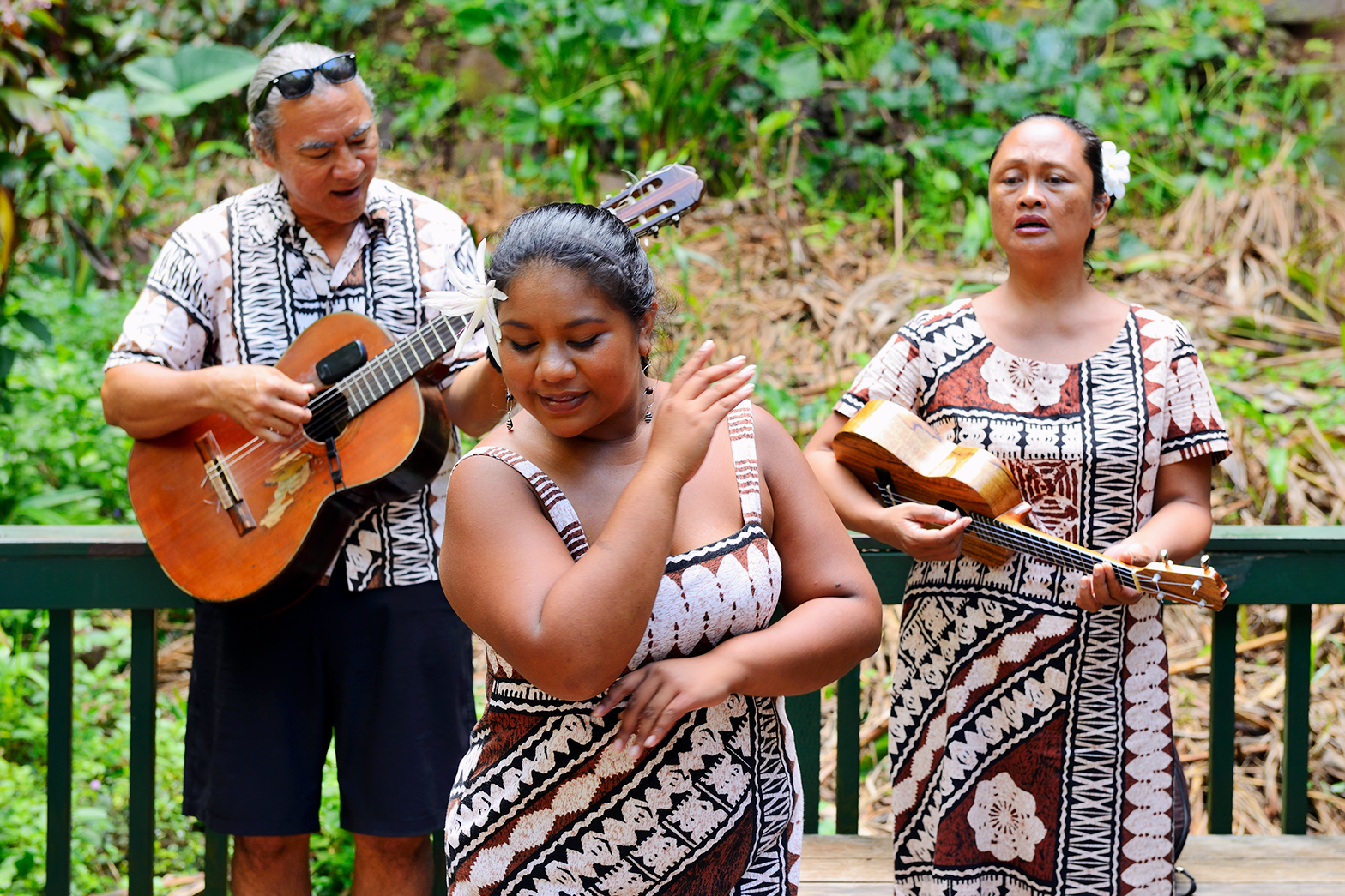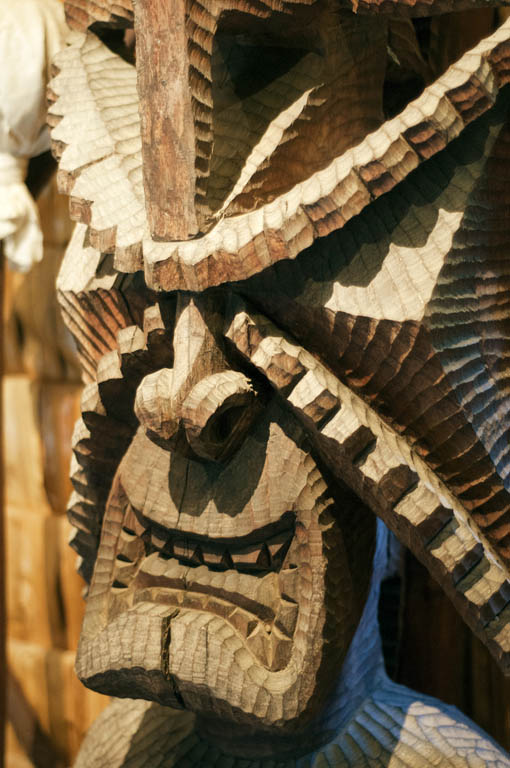Hawaiian Arts & Crafts
E komo mai (welcome) to these unique Polynesian islands, where storytelling and slack key guitar are among the sounds of everyday life. Contemporary Hawaii is a vibrant mix of multicultural traditions and underneath it all beats a Hawaiian heart, pounding with an ongoing revival of Hawaii’s indigenous language, artisanal crafts, music and the hula.

Hula
In ancient Hawaiʻi, hula sometimes was a solemn ritual, in which mele (songs, chants) were an offering to the gods or celebrated the accomplishments of aliʻi (chiefs). At other times hula was lighthearted entertainment, in which chief and kamaʻaina (commoner) danced together,including at annual festivals such as the makahiki held during harvest season. Most importantly, hula embodied the community – telling stories of and celebrating itself.
Traditionally, dancers trained rigorously in halau (schools) under akumu (teacher), so their hand gestures, facial expressions and synchronized movements were exact. In a culture without written language, chants were important, giving meaning to the movements and preserving Hawaii’s oral history, anything from creation stories about gods to royal genealogies. Songs often contained kaona (hidden meanings), which could be spiritual, but also slyly amorous, even sexual.
Hula still thrives today, with competitions and expositions thriving across the islands.
Island Music
Hawaiian music is rooted in ancient chants. Foreign missionaries and sugar-plantation workers introduced new melodies and instruments, which were incorporated and adapted to create a unique local musical style. Leo kiʻekiʻe (falsetto, or ‘high voice’) vocals, sometimes just referred to as soprano for women, employs a signature haʻi (vocal break, or split-note) style, with a singer moving abruptly from one register to another. Contemporary Hawaiian musical instruments include the steel guitar, slack key guitar and ukulele.
But if you tune your rental-car radio to today’s island radio stations, you’ll hear everything from US mainland hip-hop beats, country-and-western tunes and Asian pop hits to reggae-inspired ‘Jawaiian’ grooves. A few Hawaii-born singer-songwriters, most famously Jack Johnson, have achieved international stardom. To discover new hitmakers, check out this year’s winners of the Na Hoku Hanohano Awards (www.nahokuhanohano.org), Hawaii’s version of the Grammies.
Ukelele
Heard all across the islands is the ukulele, derived from the braguinha, a Portuguese stringed instrument introduced to Hawaii in 1879. Ukulele means ‘jumping flea’ in Hawaiian, referring to the way players’ deft fingers swiftly move around the strings. The ukulele is enjoying a revival as a young generation of virtuosos emerges, including Nick Acosta, who plays with just one hand, and genre-bending rockers led by Jake Shimabukuro, whose album Peace Love Ukulele (2011) reached number one on Billboard’s world music chart.
Both the ukulele and the steel guitar contributed to the lighthearted hapa haole (Hawaiian music with predominantly English lyrics) popularized in the islands after the 1930s, of which My Little Grass Shack and Lovely Hula Hands are classic examples. For better or for worse, hapa haole songs became instantly recognizable as ‘Hawaiian’ thanks to Hollywood movies and the classic Hawaii Calls radio show, which broadcast worldwide from the banyan-tree courtyard of Waikiki’s Moana hotel from 1935 until 1975.
Cowboy Heritage
Spanish and Mexican cowboys introduced the guitar to Hawaiians in the1830s. Fifty years later, Oʻahu-born high-school student Joseph Kekuku started experimenting with playing a guitar flat on his lap while sliding a pocket knife or comb across the strings. His invention, the Hawaiian steel guitar (kika kila), lifts the strings off the fretboard using a movable steel slide, creating a signature smooth sound.
In the early 20th century, Kekuku and others introduced the islands’ steel guitar sounds to the world. The steel guitar later inspired the creation of resonator guitars such as the Dobro, now integral to bluegrass, blues and other genres, and country-and-western music’s lap and pedal steel guitars. Today Hawaii’s most influential steel guitarists include Henry Kaleialoha Allen, Alan Akaka, Bobby Ingano and Greg Sardinha.
Slack Key Guitar
Since the mid-20th century, the Hawaiian steel guitar has usually been played with slack key (ki hoʻalu) tunings, in which the thumb plays the bass and rhythm chords, while the fingers play the melody and improvisations, in a picked style. Traditionally, slack key tunings were closely guarded secrets among ʻohana (extended family and friends).
The legendary guitarist Gabby Pahinui launched the modern slack key guitar era with his first recording of ‘Hiʻilawe’ in 1946. In the 1960s, Gabby and his band the Sons of Hawaii embraced the traditional Hawaiian sound. Along with other influential slack key guitarists such as Sonny Chillingworth, they spurred a renaissance in Hawaiian music that continues to this day. The list of contemporary slack key masters is long and ever growing, including Keola Beamer, Ledward Kaʻapana, Martin and Cyril Pahinui, Ozzie Kotani and George Kuo.
Traditional Crafts
In the 1970s, the Hawaiian renaissance sparked interest in artisan crafts. The most beloved traditional craft is lei-making, stringing garlands of flowers, leaves, berries, nuts or shells. More lasting souvenirs include wood carvings, woven baskets and hats, and Hawaiian quilts. All of these have become so popular with tourists that cheap imitation imports from across the Pacific have flooded into Hawaii, so shop carefully and always buy local.
Woodworking
Ancient Hawaiians were expert woodworkers, carving canoes out of logs and hand-turning lustrous bowls from a variety of beautifully grained tropical hardwoods, such as koa and milo. Ipu (gourds) were also dried and used as containers and as drums for hula. Contemporary woodworkers take native woods to craft traditional bowls, exquisite furniture, jewelry and free-form sculptures. Traditionally, Hawaiian wooden bowls are not decorated or ornate, but are shaped to bring out the natural beauty of the wood. The thinner and lighter the bowl, the finer the artistry and greater the value – and the price. Don’t be fooled into buying cheaper monkeypod bowls imported from the Philippines.

Fabric Arts
Lauhala weaving and the making of kapa (pounded-bark cloth) for clothing and artworks are two ancient Hawaiian crafts.
Traditionally lauhala served as floor mats, canoe sails, protective capes and more. Weaving the lau (leaves) of the hala (pandanus) tree is the easier part, while preparing the leaves, which have razor-sharp spines, is messy work. Today the most common lauhala items are hats, placemats and baskets. Most are mass-produced, but you can find handmade beauties at specialty stores.
Making kapa (called tapa elsewhere in Polynesia) is no less laborious. First, seashells are used to scrape away the rough outer bark of the wauke (paper mulberry) tree. Strips of softer inner bark are cut (traditionally with shark’s teeth), pounded with mallets until thin and pliable, and further softened by being soaked in water to let them ferment between beatings. Softened bark strips are then layered atop one another and pounded together in a process called felting. Large sheets of finished kapa are colorfully dyed with plant materials and stamped or painted by hand with geometric patterns before being scented with flowers or oils.
In ancient times, kapa was worn as everyday clothing by both sexes and used as blankets for everything from swaddling newborns to burying the dead. Today authentic handmade Hawaiian kapa cloth is rarely seen outside of museums, fine-art galleries and private collections.
Island Writings
From Outside & Inside
Until the late 1970s, Hawaii’s literature was dominated by nonlocal Western writers observing these exotic-seeming islands from the outside. Globetrotters such as Mark Twain and Isabella Bird wrote the earliest travelogues about the islands. Best-selling modern titles include James Michener’s historical saga, Hawaii (1959), and Paul Theroux’s caustically humorous Hotel Honolulu (2001). More recently, Hawaii-centered historical fiction written by nonresidents includes The Last Aloha (2009), by Gaellen Quinn, and Bird of Another Heaven (2007), by James Houston.
Meanwhile, locally born contemporary writers have created an authentic literature of Hawaii that evokes island life from the inside. Leading this movement has been Bamboo Ridge Press (www.bambooridge.com), which for almost four decades has published new local fiction and poetry in an annual journal and has launched the careers of many contemporary writers in Hawaii. The University of Hawaiʻi Press (www.uhpress.hawaii.edu) and Bishop Museum Press (www.bishopmuseum.org) have also made space for local writers to air their voices, especially with insightful nonfiction writings about Hawaiian culture, history, nature and art.
Pidgin Beyond Plantations
In 1975, All I Asking for Is My Body, by Milton Murayama, vividly captured sugar plantation life for Japanese nisei (second-generation immigrants) around WWII. Murayama’s use of pidgin opened the door to an explosion of vernacular literature. Lois-Ann Yamanaka has won widespread acclaim for her poetry (Saturday Night at the Pahala Theatre,1993) and stories (Wild Meat and the Bully Burgers, 1996), in which pidgin embodies her characters like a second skin.
Indeed, redeeming pidgin – long dismissed by academics and disparaged by the upper class – has been a cultural and political cause for some. The hilarious stories (Da Word, 2001) and essays (Living Pidgin, 2002) of Lee Tonouchi, a prolific writer and playwright whose nickname is ‘Da Pidgin Guerrilla,’ argue that pidgin is not only essential to understanding local culture, but is also a legitimate language. Another great introduction to pidgin is Growing Up Local (1998), an anthology of poetry and prose published by Bamboo Ridge Press.
Hawaii on Screen
Nothing has cemented the paradisaical fantasy of Hawaii in the popular imagination as firmly as Hollywood. Today, Southern California’s ‘dream factory’ continues to peddle variations on a South Seas genre that first swept movie theaters in the 1930s. Whether the mood is silly or serious,whether Hawaii is used as a setting or a stand-in for someplace else, the story’s familiar tropes rarely change, updating the original tropical castaways soap opera and often romantically glossing over the islands’ history of colonization.
Hollywood arrived in Hawaii in 1913, more than a decade after Thomas Edison first journeyed here to make movies that you can still watch today at Lahaina's Wo Hing Museum on Maui. By 1939, dozens of Hollywood movies had been shot in Hawaii, including the musical comedy Waikiki Wedding (1937), in which Bing Crosby crooned the Oscar-winning song ‘Sweet Leilani.’ Later favorites include the WWII–themed drama From Here to Eternity (1953), the musical South Pacific (1958), and Elvis Presley’s goofy postwar Blue Hawaii (1961). Today, Hawaii actively encourages and supports a lucrative film industry by maintaining state-of-the-art production facilities and providing tax incentives. Hundreds of feature films have been shot in the state, including box-office hits Raiders of the Lost Ark (1981), Jurassic Park (1993), Pearl Harbor (2001), 50 First Dates (2004), Pirates of the Caribbean: On Stranger Tides (2011), The Hunger Games: Catching Fire (2013) and Jurassic World (2015).
Hawaii has hosted dozens of TV series since 1968, when the original Hawaii Five-O, an edgy cop drama unsentimentally depicting Honolulu’s gritty side, debuted. In 2010 Hawaii Five-O was rebooted as a prime-time drama, filmed on Oʻahu. That island also served as the location for the hit series Lost, which, like Gilligan’s Island (the pilot of which was filmed on Kauaʻi), is about a group of island castaways trying to get home.
For a complete filmography and a list of hundreds of TV episodes filmed here, including what’s currently being shot around the islands, check the Hawaii Film Office website, http://filmoffice.hawaii.gov.